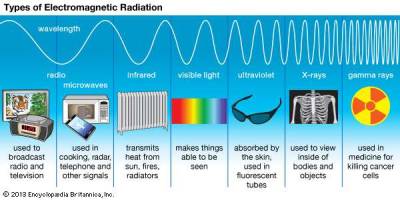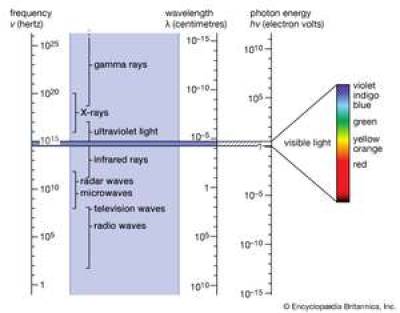
This is an old revision of the document!
Table of Contents
Physics of light
Beyond the visible spectrum of light, there is ultraviolet (UV) light (which are the short, invisible electromagnetic wave lengths) at one end of the spectrum, and there is infrared (IR) light (which are longer, invisible electromagnetic wavelengths) at the other end of the spectrum. These forms of light are known as incident radiation.
Both the visible wave lengths and the invisible UV and IR wave lengths can provide enough solar electromagnetic energy to cause the creation of the secosteroidal hormone 1,25-D within the keratinocytes of the skin and also within the eyes by converting sterol precursors into 1,25-DPrimary biologically active vitamin D hormone. Activates the vitamin D nuclear receptor. Produced by hydroxylation of 25-D. Also known as 1,25-dihydroxycholecalciferol, 1,25-hydroxyvitamin D and calcitirol.. For that reason, Marshall ProtocolA curative medical treatment for chronic inflammatory disease. Based on the Marshall Pathogenesis. (MP) patients must limit their exposure to incident radiation.
Any radiation, even heat or diathermy (a medical procedure that involves generating local heat in body tissues by high-frequency electromagnetic currents), will upset the way the immune system deals with pathogens.
Effect the amount of energy has on the disease process
The only radiation which is important when considering 1,25-D generation is radiation that carries considerable energy with it. For a given intensity of radiation, UV is the most energetic. The energy falls off with increasing wavelength (towards visible and IR). There still is enough energy for individuals with Th1 diseaseAny of the chronic inflammatory diseases caused by bacterial pathogens. to sense, and be affected by, in hot plates and direct-radiation saunas, but lower intensities of IR energy do not cause any problems. The important characteristic of IR energy is that it cannot be seen.
The production of 1,25-D by the skin has very little to do with UV and everything to do with energy of the incident radiation. One study demonstrated that blocking ultraviolet-B rays did not reduce the production of 1,25-D in the skin.1) (The sunscreen tested did not contain the broad spectrum sunscreen ingredient, zinc oxide.
Infrared light's effect on the creation of vitamin D
MP patients may need to wear special glasses that block transmissionAn incident in which an infectious disease is transmitted. of infrared light, the energetically weakest form of light. Several people have asked why patients shouldn't be more concerned about more powerful wavelengths of light such as ultraviolet. There are several reasons why it's important to be concerned about all forms of light, including infrared:
Firstly the quanta of energy do not vary that much between near-UV and visible and Far-IR. Maybe by a factor of three or so, but nobody has shown that the 7-dehydrocholesterolA cholesterol precursor manufactured by humans. When exposed to ultraviolet light converted into vitamin D3. Also known as previtamin-D3. steroid ring cleavage requires that much energy. In fact, all the current pragma about UV has been based on in vitroA technique of performing a given procedure in a controlled environment outside of a living organism - usually a laboratory. work, which is subject to many, many, errors. We need to study this at the molecular level to be sure.
The other issue is that we know TNF-alphaA cytokine critical for effective immune surveillance and is required for proper proliferation and function of immune cells. catalyzes the production of 1,25-D in keratinocytes. That speaks to a continuous process, not a quantized reaction.
Finally, the hundreds of folks on the MP are keeping away from UV like the plague, yet they continue to produce 1,25-D.
Trevor Marshall, PhD
Sources of incident radiation
IR rays create most of the heat derived from sunlight and incandescent light bulbs. Humans perceive IR radiation as “heat radiation,” which is one way of energy transport. This may be why many persons with Th1 disease feel very uncomfortable when they get overheated. With those who are most seriously ill, even infrared radiation from furnaces and similar heat sources can cause problems.
The greatest source of IR radiation is daylight. The following are other sources of incident radiation, but they can be used safely by MP patients:
- computer or TV monitors or movie screens (but the light may be too bright)
- steam saunas with the heat generator hidden from view
- fireplaces and heaters
MP patients should not use the following sources of incident radiation:
- infrared saunas and infrared heaters
- saunas with electric coils under lava rocks
- Bioptron light therapy (This source states Bioptron light therapy is a source of infrared radiation. “The permeation effect is generated by the slightly calorific infrared portion of the Bioptron Light spectrum.”
- Laser hair removal, because it targets hair follicles and heats them with infrared energy
Blocking incident radiation
Ordinary window glass can block the UV wave lengths of invisible light, but it cannot block either the visible wave lengths of light nor can it block the IR wave lengths of invisible light. This effect is most noticeable when one feels the warmth of the sun's rays on the skin through the windows of a car, even if the windows are tinted, because some of the wave lengths can still penetrate the car windows. Window films, even those that claim to shield from UV and IR, that allow visible light to penetrate are not enough protection. Bright surfaces, like snow, concrete and sand, reflect UV light and can nearly double the amount that gets to the skin and eyes.
Candlelight and light from a fireplace should not be problematic for MP patients, however, patients should not stare at the light without the protection of sunglasses.
MP patients must cover their home's windows with thick material to keep out all light or continue to cover their skin and protect their eyes from IR radiation while indoors. The level of artificial light indoors should not exceed 30 lux.
When outside or exposed to daylight, MP patients must shield their skin from exposure.
Eye protection is essential for most MP patients. NoIR and other equivalent eyewear block IR and UV radiation in addition to most visible light.
the spectrum
Further reading
Notes and comments
- Legacy content



